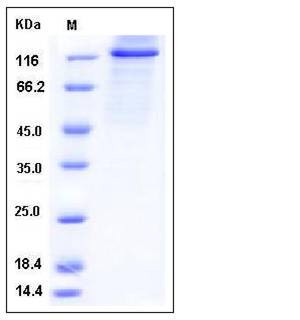Human PRKD2 / PKD2 Protein (His & GST Tag)
HSPC187,nPKC-D2,PKD2
- 100ug (NPP2431) Please inquiry
| Catalog Number | P11671-H20B |
|---|---|
| Organism Species | Human |
| Host | Baculovirus-Insect Cells |
| Synonyms | HSPC187,nPKC-D2,PKD2 |
| Molecular Weight | The recombinant human PRKD2/GST chimera consists of 1115 amino acids and has a calculated molecular mass of 124 kDa. It migrates as an approximately 120 kDa band in SDS-PAGE under reducing conditions. |
| predicted N | Met |
| SDS-PAGE |  |
| Purity | > 82 % as determined by SDS-PAGE |
| Protein Construction | A DNA sequence encoding the amino acid sequence (Met 1-Leu 878) of human PRKD2 (NP_057541.2) was fused with the N-terminal polyhistidine-tagged GST tag at the N-terminus. |
| Bio-activity | The specific activity was determined to be 86 nmol/min/mg using synthetic CREBtide peptide (KRREILSRRPSYR) as substrate. |
| Research Area | Cancer |Signal transduction |Other Related Intracellular Topics |Cellular Senescence and Pathways in Aging |Wnt Family |Wnt Intracellular Signaling | |
| Formulation | Supplied as sterile 50mM Tris, 500mM NaCl, 0.5mM PMSF, 10% glycerol, pH 8.0 1. Normally 5 % - 8 % trehalose, mannitol and 0.01% Tween80 are added as protectants before lyophilization. Specific concentrations are included in the hardcopy of COA. |
| Background | Serine/threonine-protein kinase D2, also known as PRKD2 and PKD2, is a cytoplasm and membrane protein which belongs to the protein kinase superfamily, CAMK Ser/Thr protein kinase family and PKD subfamily. PRKD2 / PKD2 is widely expressed. It contains one PH domain, two phorbol-ester/DAG-type zinc fingers and one protein kinase domain. PRKD2 / PKD2 is activated by DAG and phorbol esters. Phorbol-ester/DAG-type domains bind DAG, mediating translocation to membranes. Autophosphorylation of Ser-710 and phosphorylation of Ser-706 by PKC relieves auto-inhibition by the PH domain. PRKD2 / PKD2 converts transient diacylglycerol (DAG) signals into prolonged physiological effects, downstream of PKC. Involved in resistance to oxidative stress. |
| Reference |
